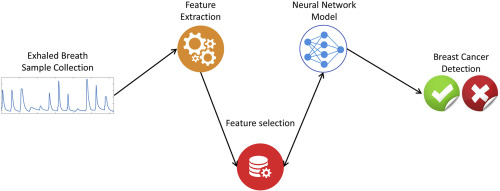A new method for early and accurate breast cancer screening has been developed by researchers at BGU and Soroka University Medical Center, using commercially available technology.
The researchers were able to isolate relevant data patterns to more accurately identify breast cancer biomarkers using two different electronic nose gas sensors for breath, along with gas-chromatography mass spectrometry (GC-MS) to quantify patterns of substances found in urine.
In their study published in Computers in Biology and Medicine, researchers detected breast cancer with more than 95 percent average accuracy using two different commercial electronic noses (e-nose) that identifies unique breath patterns in women with breast cancer. In addition, their revamped statistical analyses of urine samples submitted both by healthy patients and those diagnosed with breast cancer yielded 85 percent average accuracy.

“Breast cancer survival is strongly tied to the sensitivity of tumor detection; accurate methods for detecting smaller, earlier tumors remains a priority," says Prof. Yehuda Zeiri, a member of BGU's Department of Biomedical Engineering. “Our new approach utilizing urine and exhaled breath samples, analyzed with inexpensive, commercially available systems, is non-invasive, accessible and may be easily implemented in a variety of settings."
The study reports breast cancer is the most commonly diagnosed malignancy among females and the leading cause of death around the world. In 2016, breast cancer accounted for 29 percent of all new cancers identified in the United States and was responsible for 14 percent of all cancer-related deaths.
Mammography screenings, which are proven to significantly reduce breast cancer mortality, are not always able to detect small tumors in dense breast tissue. In fact, typical mammography sensitivity, which is 75 to 85 percent accurate, decreases to 30 to 50 percent in dense tissue.
Current diagnostic imaging detection for smaller tumors has significant drawbacks: dual-energy digital mammography, while effective, increases radiation exposure, and magnetic resonance imaging (MRI) is expensive. Biopsies and serum biomarker identification processes are invasive, equipment-intensive and require significant expertise.
“We've now shown that inexpensive, commercial electronic noses are sufficient for classifying cancer patients at early stages," says Prof. Zeiri. “With further study, it may also be possible to analyze exhaled breath and urine samples to identify other cancer types, as well."
Study contributors include: BGU biomedical engineering researchers Prof. Yehuda Zeiri, Or Herman-Saffar, Zvi Boger, and Raphael Gonen; Dr. Shai Libson, a surgeon in the Breast Health Center at Soroka; and Dr. David Lieberman, an associate professor in BGU's Joyce and Irving Goldman Medical School.
Media Coverage
Medical Xpress
Jerusalem Post
Times of Israel